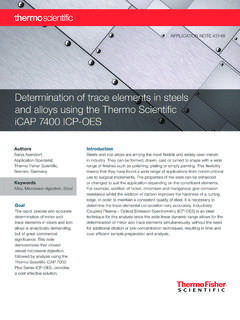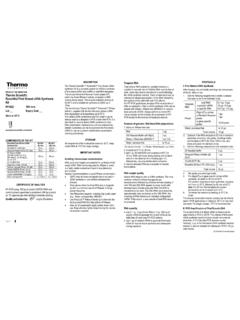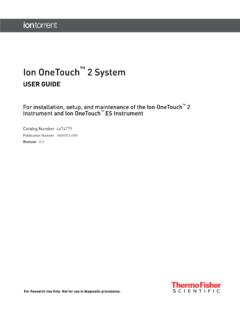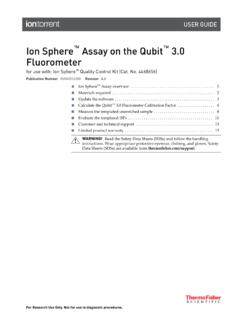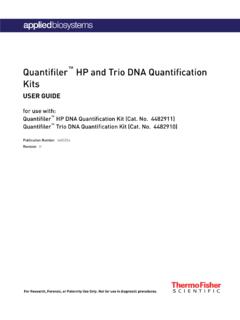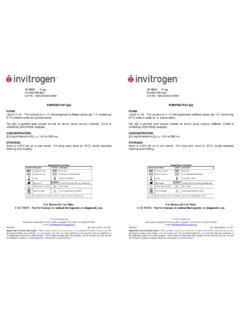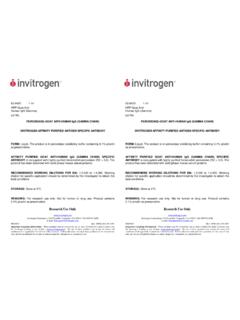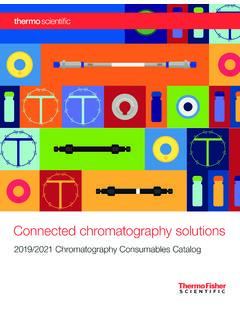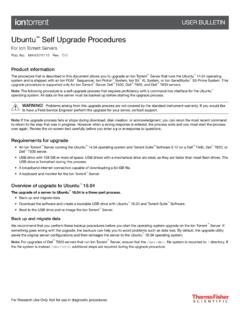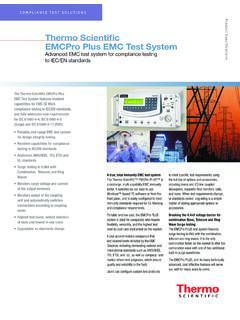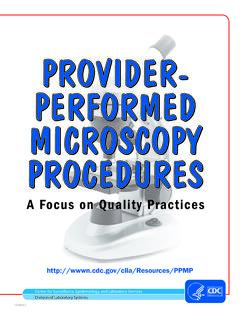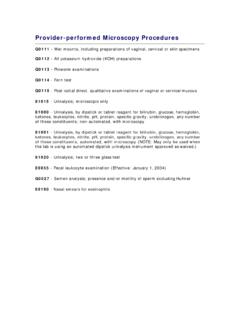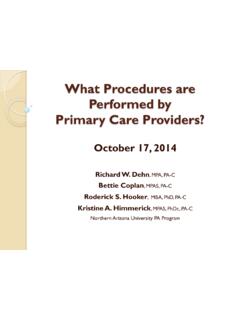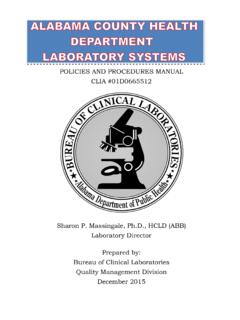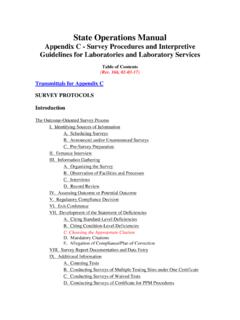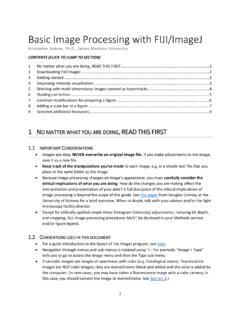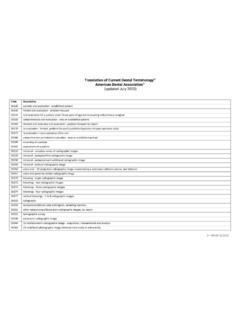Transcription of Propidium Iodide Nucleic Acid Stain
1 Revised: 16 March 2006 | MP 01304 Table 1. Contents and storage Iodide solid (including FluoroPure PI *) (P1304MP, P21493)100 mgRoom temperatureProtect from light When stored as directed, product is stable at least 1 Iodide solution (P3566)1 mg/mL in water2 6 CProtect from light When stored as directed, solution is stable at least 6 months.* 98% fluorescence excitation/emission maxima: 535/617 nm, bound to Nucleic acidsPropidium Iodide Nucleic Acid StainIntroductionPropidium Iodide (PI) binds to DNA by intercalating between the bases with little or no sequence preference and with a stoichiometry of one dye per 4 5 base pairs of PI also binds to RNA, necessitating treatment with nucleases to distinguish between RNA and DNA staining.
2 Once the dye is bound to Nucleic acids, its fluorescence is enhanced 20- to 30-fold, the fluorescence excitation maximum is shifted ~30 40 nm to the red and the fluorescence emis-sion maximum is shifted ~15 nm to the Although its molar absorptivity (extinction coefficient) is relatively low, PI exhibits a sufficiently large Stokes shift to allow simultaneous detection of nuclear DNA and fluorescein-labeled antibodies, provided the proper optical filters are used. PI is suitable for fluorescence microscopy , confocal laser scanning micro-scopy, flow cytometry, and is membrane impermeant and generally excluded from viable cells.
3 PI is commonly used for identifying dead cells in a population and as a counterstain in multicolor fluorescent tech-niques. The counterstaining protocols below are compatible with a wide range of cytological labeling techniques direct or indirect antibody-based detection methods, mRNA in situ hybridization, or staining with fluorescent reagents specific for cellular structures. These protocols can be modified for tissue Iodide Nucleic Acid Stain | 2 Before You Begin Materials Required but Not ProvidedSee the protocols below to determine materials required for your particular use of Microscopy2X SSCDNase-free RNaseAntifade reagent, such as SlowFade Gold (S36936) or ProLong Gold (P36930) antifade reagents ORFlow CytometryPBSE thanolTris staining buffer (see step )ORChromosome FISHdH2 OPBSRNase AAntifade reagent, optionalMaking a Stock Solution from Solid PITo make a stock solution from the solid form, dissolve PI (MW = ) in deionized water (dH2O) at 1 mg/mL ( mM)
4 And store at 2 6 C, protected from light. When stored properly, solutions are stable for at least six months. CautionPI is a potential mutagen and should be handled with care. The dye must be disposed of safely and in accordance with applicable local regulations. Propidium Iodide Nucleic Acid Stain | 3 Fluorescence Spectral CharacteristicsWhen bound to Nucleic acids, the fluorescence excitation maximum for PI is 535 nm and the emission maximum is 617 nm (Figure 1). PI can be excited with a xenon or mercury-arc lamp or with the 488 line of an argon-ion laser. Generally, PI fluorescence is detected in the FL2 channel of flow cytometers.
5 Figure 1. Fluorescence excitation and emission profiles of Propidium Iodide bound to (nm)Fluorescence emissionFluorescence excitationExperimental ProtocolsCounterstaining Adherent Cells for Fluorescence MicroscopyPreparing the SampleUse the fixation protocol appropriate for your sample. PI staining is normally performed after all other staining. Note that permeabilization of the cells is required for counterstaining with TreatmentRNase treatment is required if the sample is fixed in paraformaldehyde, formaldehyde, or glutaraldehyde. If the sample is fixed with methanol/acetic acid or acetone, RNase treatment is usually not required.
6 Equilibrate the sample briefly in 2X SSC ( M NaCl, M sodium citrate, pH ). Incubate the sample in 100 g/mL DNase-free RNase in 2X SSC for 20 minutes at 37 C. Rinse the sample three times, 1 minute each, in 2X SSC. Counterstaining Equilibrate the sample in 2X SSC. Make a 500 nM solution of PI by diluting the 1 mg/mL ( mM) stock solution 1:3000 in 2X SSC. About 300 L is usually enough Stain for one coverslip preparation. Incubate the cells, covered with the dilute Stain , for 1 5 Iodide Nucleic Acid Stain | 4 Rinse the sample several times in 2X SSC. Drain excess buffer from the coverslip and mount in a medium with an antifade reagent such as Molecular Probes SlowFade Gold antifade reagent (S36936) or ProLong Gold antifade reagent (P36930).
7 View sample using a fluorescence microscope with appropriate filters (see Fluorescence Spectral Characteristics).Counterstaining Cells in Suspension for Flow CytometryPreparing the SampleUse the fixation protocol appropriate for your sample, or use the following protocol. Collect a volume of cell suspension corresponding to 2 105 to 1 106 cells. Pellet the cells by centrifugation. Discard the supernatant, tap the tube to resuspend the pellet in the residual liquid and add 1 mL of phosphate-buffered saline (PBS) at room temperature. Transfer the full volume of resuspended cells to 4 mL of absolute ethanol at 20 C by pipet-ting the cell suspension slowly into the ethanol while vortexing at top speed.
8 Leave the cells in ethanol at 20 C for 5 15 minutes. Pellet the cells by centrifugation, discard the ethanol, tap the tube to loosen the pellet, and add 5 mL of PBS at room temperature. Allow the cells to rehydrate for 15 Make a 3 M solution of PI by diluting the 1 mg/mL ( mM) stock solution 1:500 in staining buffer (100 mM Tris, pH , 150 mM NaCl, 1 mM CaCl2, mM MgCl2, Nonidet P-40). A 1 mL volume will be required for each cell sample. Centrifuge the cell suspension from step , discard the supernatant, tap to loosen the pellet, and add 1 mL of PI diluted in staining buffer. Incubate for 15 minutes at room temperature and analyze by flow cytometry in the presence of the dye.
9 If the cells are to be viewed by fluo-rescence microscopy , centrifuge the sample, remove the supernatant, and resuspend the cells in fresh buffer. Apply a drop of the suspension to a microscope slide, cover with a coverslip, and view using appropriate filters (see Fluorescence Spectral Characteristics).Counterstaining the Specimen by Chromosome FISHP reparing the SamplePrepare the specimen according to standard ,4 Briefly rinse the final preparations in dH2O before counterstaining to remove residual buffer salts from the slide. Air dry. This final rinse will help reduce nonspecific background staining on the Make a M PI staining solution by diluting the 1 mg/mL ( mM) stock solution 1:1000 in PBS.
10 Pipet 300 L of this staining solution directly onto the specimen. If necessary, RNase A (freshly made) may be added to a final concentration of 10 g/mL. A plastic coverslip can be used to distribute the dye evenly on the slide. Incubate the specimen in the dark for 30 minutes at room temperature, or at 37 C if RNase is Iodide Nucleic Acid Stain | Contact InformationMolecular Probes, Inc. 29851 Willow Creek Road Eugene, OR 97402 Phone: (541) 465-8300 Fax: (541) 335-0504 Customer Service: 6:00 am to 4:30 pm (Pacific Time) Phone: (541) 335-0338 Fax: (541) 335-0305 Ordering for USA: Order Phone: (800) 438-2209 Order Fax: (800) 438-0228 Technical Service: 8:00 am to 4:00 pm (Pacific Time) Phone: (541) 335-0353 Toll-Free (800) 438-2209 Fax: (541) 335-0238 European Headquarters Invitrogen, Ltd.
